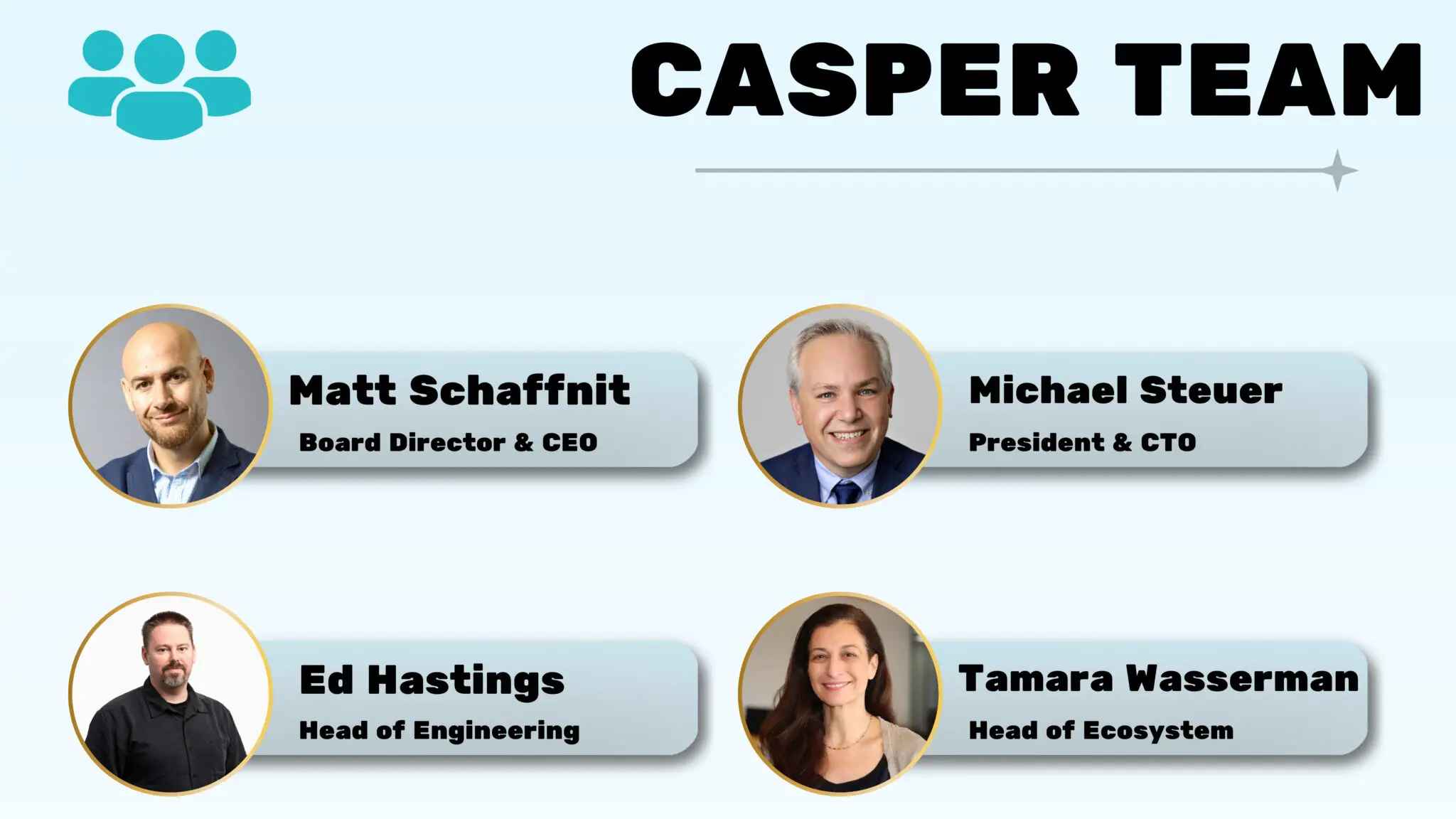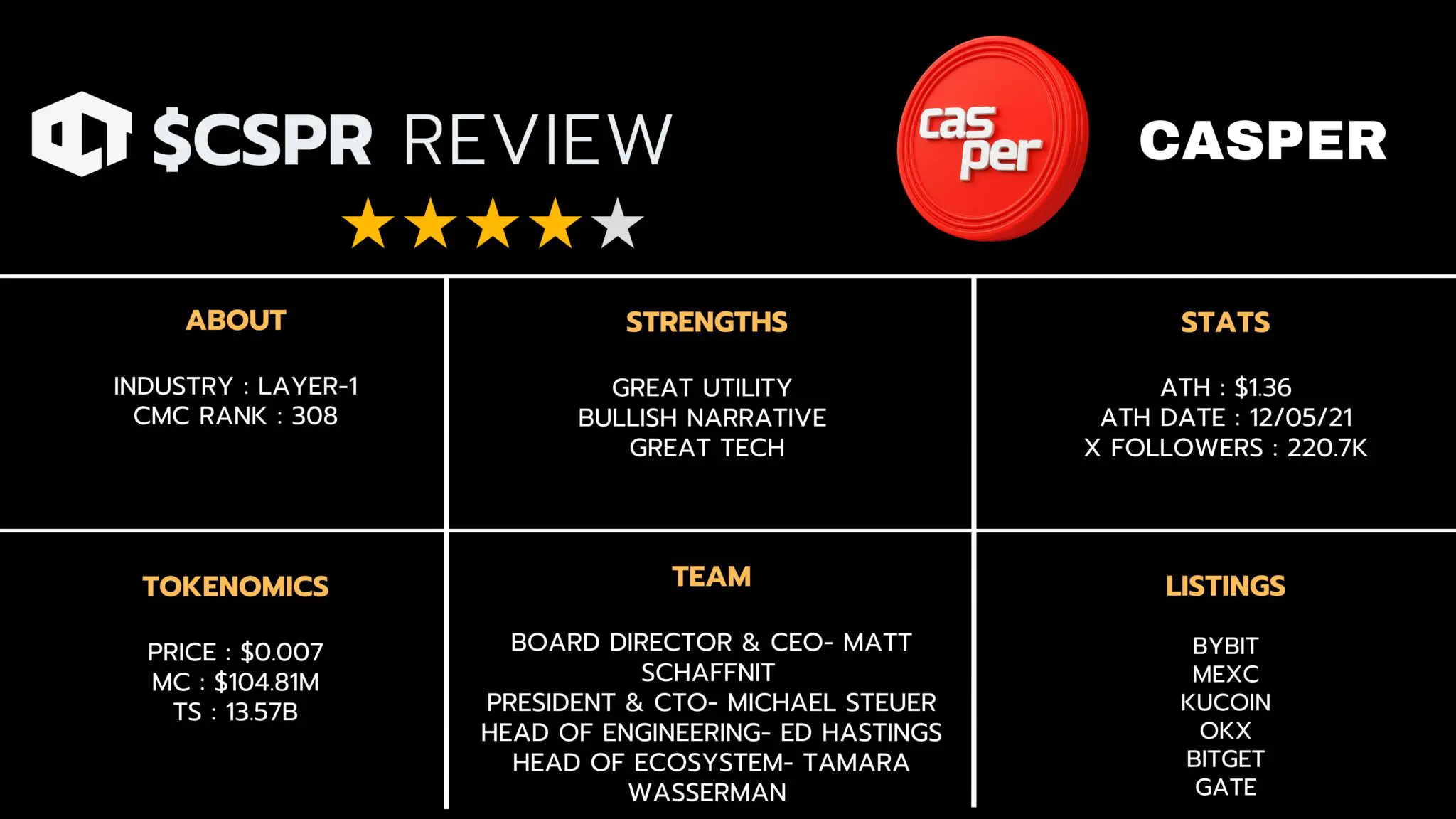
Casper ($CSPR) review covering consensus, access control, upgradeable contracts, multi-VM architecture, and real-world enterprise adoption.
Author: Akshat Thakur
Published On: Mon, 10 Nov 2025 03:31:06 GMT
This Casper Review examines how Casper is positioning itself as one of the most practical and enterprise-ready Layer-1 blockchains, engineered specifically for real-world adoption. While most chains focus on decentralized finance or experimental on-chain applications, Casper aims to bridge the long-standing gap between traditional industries and Web3. Its architecture prioritizes security, auditability, upgradeability, and predictable executionqualities enterprises require but rarely find in blockchain systems.
Rather than competing solely on raw throughput or maximal decentralization, Casper focuses on reliability and operational flexibility. Casper’s design philosophy mirrors the real-world economy: transactions must finalize instantly, permissions must reflect actual business hierarchies, and software must remain upgradable without requiring destructive migrations. Casper is not built for speculation it’s built for companies, governments, and builders who need trustworthy infrastructure capable of supporting critical business workflows.
With the release of Casper 2.0, the network introduces major advancements such as Zug Consensus, native access control, multi-signature support, multi-virtual machine capabilities, smart contract upgradeability, factory contracts, and developer-friendly tooling. This combination positions Casper as a chain capable of powering tokenized assets, enterprise workflows, financial instruments, compliance-sensitive applications, and large-scale decentralized systems.
Casper’s technology stack is engineered around modularity, security, and long-term adaptability:
Collectively, these components provide a robust and flexible foundation for enterprise blockchain applications.
Casper’s tokenomics are designed to reward long-term network participation while supporting enterprise-grade applications.
Exchange Listings:
Liquidity:
Casper is backed by a team of veteran engineers, distributed systems researchers, cryptographers, and enterprise technology specialists. Their work is supported by years of development experience and deep expertise in both Web2 and Web3 infrastructure.

| Project | Core Focus & Innovation | Compliance / Identity | Performance & Notes |
|---|---|---|---|
|
| Upgradeable smart contracts, deterministic finality (Zug), WASM execution, and enterprise-friendly permissioning. | Permissionless network; optional role-based access control inside contracts. | Reliable finality and predictable behavior; not optimized for maximum throughput; smaller ecosystem and limited adoption compared to major L1s. |
|
| |||
|
| |||
|
| |||
|
| Move language focused on safety and resource control; high-performance execution. | Permissionless. | |
|
|
Casper’s forward trajectory focuses on:
Casper is steadily becoming one of the most thoughtfully engineered Layer-1s in the industry one tailored not for hype cycles or speculative experimentation, but for the real-world economy. Its design choices reflect an understanding of how businesses, institutions, and developers actually operate: they need certainty, auditability, upgradeability, clear permissions, and infrastructure that can evolve without breaking. Casper brings these qualities together in a way that few chains attempt and even fewer achieve.
By combining deterministic finality, native access control, upgradable smart contracts, and a multi-VM architecture, Casper delivers an execution layer that is both future-proof and grounded in present-day utility. For enterprises exploring tokenization, compliance-driven applications, or long-term blockchain adoption, Casper offers a stable, security-first foundation. And for developers who want Web3 without abandoning Web2 workflows, Casper removes historical barriers to entry that have held the industry back.
While Casper still faces challenges such as market visibility, competitive differentiation, and the slow pace of enterprise onboarding its technology stack positions it well against rivals like Algorand, Ethereum, Aptos, and Solana. Casper isn’t trying to outcompete them on speed or popularity; instead, it is carving out a space where reliability, governance, and real-world logic come first.
Casper is building a blockchain ecosystem that mirrors the operational realities of modern business: predictable, transparent, maintainable, and secure. As the blockchain industry matures beyond experimentation and into regulated, mission-critical use cases, Casper stands out as one of the few networks ready to support that transition. Its long-term value will depend on adoption, but its architecture already demonstrates that real-world blockchain infrastructure is not only possible it’s here.



| Largest smart contract platform; foundational EVM ecosystem with broad tooling and developer network. |
| Permissionless; identity handled through external frameworks. |
| Highly secure and battle-tested; slow finality and higher fees; lacks native contract upgradeability (relies on proxy patterns). |
| High-throughput, parallel execution (Sealevel) enabling fast and cheap transactions. |
| Permissionless. |
| Very fast and scalable; experienced multiple outages historically; strong ecosystem growth in payments, DeFi, and consumer apps. |
| Efficient PoS chain with quick finality and simple contract environment. |
| Permissionless. |
| Consistent performance and low fees; smaller developer activity; limited flexibility vs. richer VM environments. |
| Strong throughput and safety guarantees; Move has a steeper learning curve and limited familiarity among mainstream developers. |
| Object-based execution model tailored for parallelism and asset-centric operations. |
| Permissionless. |
| Very high performance for specific workloads; early ecosystem; model differs significantly from traditional smart contract chains. |